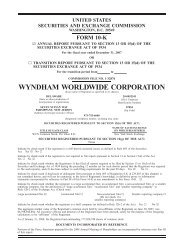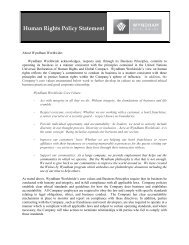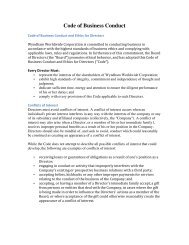WYNDHAM WORLDWIDE CORPORATION
WYNDHAM WORLDWIDE CORPORATION
WYNDHAM WORLDWIDE CORPORATION
You also want an ePaper? Increase the reach of your titles
YUMPU automatically turns print PDFs into web optimized ePapers that Google loves.
Vacation Rental Capital Leases. The Company leases vacation homes located in European holiday parks as part<br />
of its vacation exchange and rentals business. The majority of these leases are recorded as capital lease obligations<br />
under generally accepted accounting principles with corresponding assets classified within property, plant and<br />
equipment on the Consolidated Balance Sheets. The vacation rentals capital lease obligations had a weighted average<br />
interest rate of 4.5% during 2010, 2009 and 2008.<br />
Other. The Company also maintains other debt facilities which arise through the ordinary course of operations.<br />
This debt primarily reflects borrowings used to fund property renovations at one of the Company’s vacation rentals<br />
businesses.<br />
Early Extinguishment of Debt<br />
In connection with the early extinguishment of the term loan facility during the first quarter of 2010, the<br />
Company effectively terminated a related interest rate swap agreement, which resulted in the reclassification of a<br />
$14 million unrealized loss from accumulated other comprehensive income to interest expense during the first<br />
quarter of 2010 on the Company’s Consolidated Statement of Operations. The Company incurred an additional<br />
$2 million of costs during the first quarter of 2010 in connection with the early extinguishment of its term loan and<br />
revolving foreign credit facilities, which is also included within interest expense on the Company’s Consolidated<br />
Statement of Operations. The Company’s revolving foreign credit facility was paid down with a portion of the<br />
proceeds from the 7.375% senior unsecured notes. The remaining proceeds were used, in addition to borrowings<br />
under the Company’s revolving credit facility, to pay down the Company’s term loan facility.<br />
In connection with the repurchase of a portion of the Convertible Notes and the settlement of the Call Options<br />
during the third and fourth quarters of 2010, the Company incurred a loss of $14 million during 2010, which is<br />
included within interest expense on the Company’s Consolidated Statement of Operations.<br />
Interest Expense<br />
In addition to the charges the Company incurred related to the early extinguishment of debt, interest expense<br />
incurred in connection with the Company’s other debt was $144 million, $126 million and $101 million during<br />
2010, 2009 and 2008, respectively. All such amounts are recorded within the interest expense line item on the<br />
Consolidated Statements of Operations. Cash paid related to such interest expense was $125 million, $99 million<br />
and $100 million during 2010, 2009 and 2008, respectively. Such amounts exclude cash payments related to early<br />
extinguishment of debt costs.<br />
Interest expense is partially offset on the Consolidated Statements of Operations by capitalized interest of<br />
$7 million, $12 million and $21 million during 2010, 2009 and 2008, respectively.<br />
Cash paid related to consumer financing interest expense was $90 million, $112 million and $117 million<br />
during 2010, 2009 and 2008, respectively.<br />
14. Fair Value<br />
The guidance for fair value measurements requires additional disclosures about the Company’s assets and<br />
liabilities that are measured at fair value. The following table presents information about the Company’s financial<br />
assets and liabilities that are measured at fair value on a recurring basis as of December 31, 2010, and indicates the<br />
fair value hierarchy of the valuation techniques utilized by the Company to determine such fair values. Financial<br />
assets and liabilities carried at fair value are classified and disclosed in one of the following three categories:<br />
Level 1: Quoted prices for identical instruments in active markets.<br />
Level 2: Quoted prices for similar instruments in active markets; quoted prices for identical or similar<br />
instruments in markets that are not active; and model-derived valuations whose inputs are observable or whose<br />
significant value driver is observable.<br />
Level 3: Unobservable inputs used when little or no market data is available.<br />
In certain cases, the inputs used to measure fair value may fall into different levels of the fair value hierarchy.<br />
In such cases, the level in the fair value hierarchy within which the fair value measurement falls has been<br />
determined based on the lowest level input (closest to Level 3) that is significant to the fair value measurement. The<br />
Company’s assessment of the significance of a particular input to the fair value measurement in its entirety requires<br />
judgment, and considers factors specific to the asset or liability.<br />
F-32







